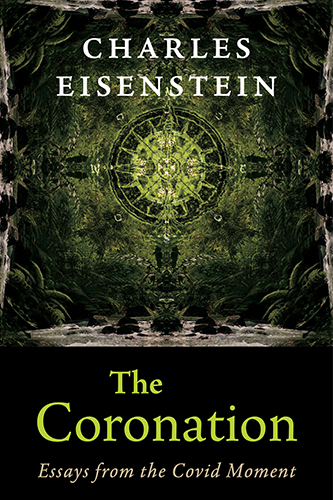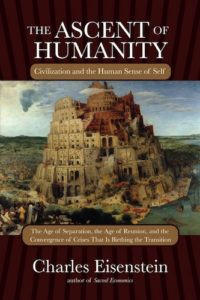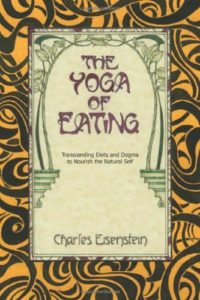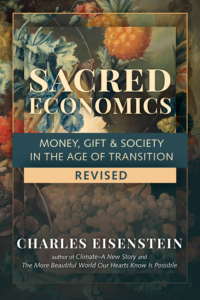The More Beautiful World Our Hearts Know Is Possible
Chapters
Chapter 34: Consciousness
Work on the level of story is not only the key to creating a more beautiful world; it is also identical with what has always been called spiritual practice. Of course it is: at the bottom of our Story of the World is a Story of Self, with its delusions of separation from other people, from nature, from Gaia, and from anything we might call God.
In Sacred Economics I questioned the notion that we ought to pursue some unitary spiritual goal called enlightenment; indeed that such a thing, as one thing, even exists. The parallel is too close to money, the one thing from which all other blessings supposedly arise. In a society where, it is advertised, money can meet every need, money becomes not just a universal means but a universal end as well. Of course, when one achieves financial wealth one realizes that it cannot in fact meet every need: not, for example, the need for intimacy, connection, love, or meaning. Whether or not we are financially rich, we all know this. But then, rather than question the notion that achieving one thing will lead to all other things, we merely displace that one thing away from money and onto something else. Beholden to the dogma of separation of spirit and matter, we take this other thing to be, unlike money, something “spiritual.” Some call it God, some call it enlightenment, but we have not left the money-patterning of pursuing a unitary goal—the most important thing there is—to which one must render endless sacrifice.
None of this is to say there is no such thing as enlightenment or God. Perhaps it is, rather, that all the things we leave out when we create the category “God” are actually part of God as well. And perhaps our pursuit of enlightenment as a goal necessarily neglects the very things that are actually necessary for our enlightenment. Here again we see the peril of getting lost in story.
Rather than ascending a linear evolutionary axis of consciousness toward a destination called enlightenment, as most New Age metaphysics seems to teach, perhaps what is happening is more subtle. It is not for nothing that the idea of an evolution of consciousness is so compelling. From crude schemata like “transitioning from the third to the fifth dimension” to sophisticated psychosocial cartographies like Spiral Dynamics, various maps of the evolution of consciousness illuminate a real phenomenon. We are evolving. It just isn’t a linear evolution. We are entering a vast new territory, each one of us exploring a different part of it.
While I’m at it, I’d like also to question whether “consciousness” is a unitary phenomenon, something we can essentialize without distortion. I think when we try, we enter dangerous territory, the territory of “some people are more conscious than others.” The toxic consequences of that kind of elitism are all too plain. Or, if all people are equally conscious, then it becomes “Humans have it but animals don’t,” and soon we are justifying factory-style animal barns. Or, if animals have it too, then it becomes “Animals with a central nervous system have it, and plants don’t,” and soon we are justifying monocrop farming and the treatment of trees as things. Or if plants have it too, then what about water and mountains? Enough of that. What if “consciousness” is one name we give to many things? What if, like God or enlightenment, our naming of it always leaves part of it out—the very part we most need to see? As Lao Tzu said, “A name that can be named is not the true name.”
While ancient humans may have lived in a much stronger realization of interbeing than we know today, nonetheless we may say that humanity is stepping into new territory, propelled by the crisis of the old. Each of us is conscious in some ways, blind in others. When we think someone “doesn’t get it,” perhaps we are only seeing their deficiencies and missing our own; surely others can look at us and cluck that we don’t get it either. The person who doesn’t get it—that’s you. As Wayne Dyer says, “If you spot it, you’ve got it.” How could it be otherwise in a world of interbeing, where each is in all and all is in each?
It is not as if the world contains two types of people, those who get it and those who don’t; those who are conscious, awakened, or evolved, and those who are not; those who are entering the fifth dimension and those who are stuck in the third; those who are among God’s elect and those who are fated to burn in Hell. How often have you felt like an alien in a world of people who don’t get it and don’t care? The irony is that nearly everyone feels that way, deep down. When we are young the feeling of mission and the sense of magnificent origins and a magnificent destination is strong. Any career or way of life lived in betrayal of that knowing is painful and can be maintained only through an inner struggle that shuts down a part of one’s being. For a time, we can keep ourselves functioning through various kinds of addictions or trivial pleasures to consume the life-force and dull the pain. In earlier times, we might have kept the sense of mission and destiny buried for a lifetime, and called that condition maturity. No longer. The Story of the World that kept it buried is dying. The institutions that conspired to keep us addicted are crumbling. Each in his or her own way, through a different permutation of crisis and miracle, expulsion and invitation, we are starting to get it.
I have written as if the transition from the old story to the new were a singular, all-or-nothing event, but the reality is more complicated. One can live some aspects of the old and some of the new simultaneously, and in each of these aspects experience the same dynamic of crisis, collapse, the space between, and birth into the new.
A newborn is fragile and dependent, able to remain in the world only with the nurturing of those already established in it. So it is when we are born into a new dimension of the Story of Interbeing. To stay there, we need help from the people who already inhabit it and have mastered its ways. Enlightenment is a group project.
Today, the breakout of consciousness into the Story of Interbeing is happening for the first time on such a mass level as to obviate old teachings about spiritual practice, gurus, and masters. The age of the guru is over—not because we don’t need help from the outside in order to inhabit a new story, but because the transition is happening to so many people in so many ways, no one person can, on his or her own, serve the traditional function of a guru. Those who tried to serve this role in the late twentieth century, if they hadn’t the good grace to pass away or the good sense to retire from guru-ing, generally came to ignominious ends, embroiled in scandals of money, sex, and power. This wasn’t because they were charlatans—most, I believe, were people of profound insight, mystical experience, and deep practice. But the water table of consciousness had risen to such a point that it came gushing from many new springs, and none were able to hold the energy.
To be sure, there remain many teachers today with wisdom and integrity, both within and without traditional lineages, who have much to offer. I have met quite a few of them, people far wiser than myself, but each, it seemed, needed teachers of his or her own, and many of the ones I admire the most readily acknowledge that. So it is not that we can rely solely on the inner guru, as some New Age teachings would have us think. It is that the guru, unable now to incarnate in something as small as a single person, takes the form of a group. As Thich Nhat Hanh says, the next Buddha will be a sangha. As Matthew Fox says, the second coming of Christ will be the advent of Christ consciousness in everyone. Perhaps it might be said that the millennia-long work of the saints, sages, mystics, and gurus is nearing completion—they have nearly rendered themselves obsolete.
Endnote:
33. For those in the Integral community, here is something to chew on: the utility of the Spiral Dynamics map is nearing a limit, because it itself is an expression of Yellow consciousness. It is therefore ill-fitted to illuminate much about the levels beyond Yellow; at best it can translate and reduce them to the conceptual apparatus of Yellow consciousness. That has not been a problem until recently, because nothing past Yellow had really crystallized yet.






